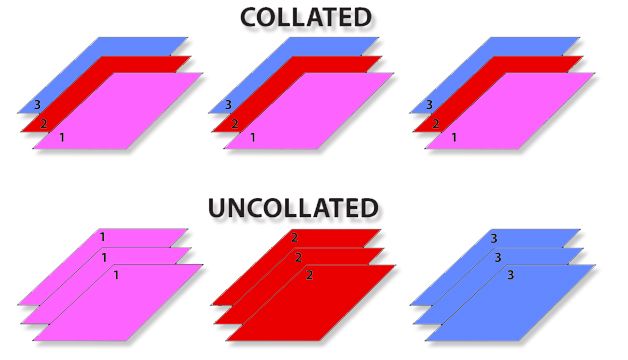Printing documents is a fundamental task in both personal and professional environments. One of the key features you might encounter on your printer settings is the option to “collate.” But what does collate on printer mean? This article will explore the concept of collation in printing, its benefits, and how to use it effectively. We will also address common questions related to collation to provide a comprehensive understanding.
What Does Collate on Printer Mean?
Collation in printing refers to arranging multiple copies of a multi-page document in the correct order. When you print several copies of a document, collation ensures that each set of pages is in the proper sequence. For instance, if you print three copies of a four-page document, collation will produce three sets of pages arranged as Without collation, the pages would be grouped by page number, resulting in three copies of page 1, three copies of page 2, and so on.
The Importance of Collation in Printing
Collation is particularly important for documents that need to be distributed in an organized manner, such as reports, booklets, and presentations. It saves time and effort that would otherwise be spent manually sorting the pages. This feature is essential in offices, schools, and any setting where multi-page documents are frequently printed.
How Does Collation Work on Printers?
Most modern printers come with an automatic collation feature. When you select the “collate” option in the print settings, the printer software ensures that each copy of the document is printed in the correct order. This function is typically managed by the printer’s driver, which communicates with the printer to organize the print job accordingly.
Steps to Enable Collation on Different Printers
Windows Printers:
Open the document you wish to print.
Click on “File” and then select “Print.”
In the print dialog box, look for the “Collate” checkbox.
Check the box to enable collation.
Click “Print” to start the job.
Mac Printers:
Open the document and go to “File” > “Print.”
In the print dialog, click on the “Copies & Pages” dropdown menu.
Select “Collate.”
Proceed to print the document.
Advanced Printer Settings:
Some printers offer advanced settings where you can customize collation options, such as setting the number of copies for each collation cycle or choosing different collation patterns.
Benefits of Using the Collate Feature on Printers
Using the collate feature on your printer provides several advantages:
Time-Saving
Collating saves significant time, especially when dealing with large documents or multiple copies. The printer automatically arranges the pages, reducing the need for manual sorting.
Increased Efficiency
For businesses and educational institutions, collation streamlines the printing process, allowing staff and students to focus on more critical tasks rather than organizing printed documents.
Error Reduction
Manual sorting of pages can lead to errors, such as missing or misordered pages. Automatic collation ensures that each copy of the document is complete and correctly ordered.
Common Questions About Collation on Printers
What is the difference between collated and uncollated printing?
Collated printing arranges the pages of multi-page documents in the correct order for each copy, while uncollated printing groups all copies of each page together. For example, collated printing
When should I use collated printing?
Collated printing is best used for documents that need to be read or distributed in order, such as manuals, booklets, and reports. It ensures that each copy is complete and ready for immediate use.
Can I collate manually if my printer does not support automatic collation?
Yes, manual collation is possible but can be time-consuming. Print the required number of copies for each page, then manually sort and arrange the pages into the correct order for each set.
What types of documents benefit most from collation?
Documents that benefit most from collation include multi-page reports, presentations, booklets, user manuals, and any other material that needs to be distributed in a specific order.
Troubleshooting Collation Issues on Printers
Even with modern printers, you might encounter issues with collation. Here are some common problems and their solutions:
Collation Option is Grayed Out
If the collation option is unavailable, it might be due to:
The printer driver not supporting collation.
The document format not being compatible with collation.
Outdated printer software or drivers.
Solution: Update your printer drivers and software, or try using a different document format.
Collation Produces Incorrect Order
If the printed documents are not in the correct order:
Check the document layout to ensure there are no blank or missing pages.
Ensure that the collation option is correctly selected in the print settings.
Verify the printer settings and ensure there are no overrides on the printer itself.
Solution: Reprint the document with the correct settings, and if the problem persists, consult the printer’s manual or support service.
Printer Jams During Collation
Printer jams can disrupt the collation process. Common causes include:
Overloaded paper tray.
Incorrect paper size or type.
Dirty or misaligned printer rollers.
Solution: Ensure the paper tray is not overloaded, use the correct paper type, and clean the printer rollers. Regular maintenance can help prevent jams.
Advanced Collation Settings and Customization
For users with specific needs, some printers offer advanced collation settings. These options allow you to customize how documents are collated:
Mixed Collation
Some printers allow mixed collation, where different sections of a document can be collated differently. For example, the main report can be collated in one order, while appendices are collated in another.
Custom Collation Patterns
Advanced printers may offer custom collation patterns, enabling users to define the order in which pages are printed. This can be useful for complex documents or presentations.
Setting Collation Defaults
Users can often set default collation settings in the printer’s software, ensuring that every print job uses the preferred collation method without needing to adjust settings each time.
Practical Applications of Collation in Various Sectors
Educational Institutions
In schools and universities, collation is crucial for preparing handouts, exams, and reports. It ensures that students and staff receive complete and organized documents.
Corporate Environments
Businesses use collation for preparing presentations, proposals, and reports. Collation enhances professionalism by delivering neatly organized documents to clients and stakeholders.
Publishing and Printing Services
Publishing houses and printing services rely heavily on collation for producing books, magazines, and brochures. Collation ensures that each copy is accurately assembled, enhancing the quality of the final product.
Conclusion
Understanding what does collate on printer mean is essential for efficient and organized printing. Collation saves time, increases efficiency, and reduces errors, making it an invaluable feature for various applications, from educational institutions to corporate environments. By enabling and properly configuring the collation feature, users can ensure their multi-page documents are printed in the correct order, ready for distribution and use.
Frequently Asked Questions (FAQs) on Collation in Printing
What is the difference between automatic and manual collation?
Automatic collation is managed by the printer and its software, organizing pages without user intervention. Manual collation requires the user to sort and arrange pages by hand.
Can collation be used with all types of printers?
Most modern printers, including inkjet and laser printers, support collation. However, some older or basic models might not have this feature.
Does collation affect printing speed?
Collation might slightly increase printing time, as the printer needs to organize the pages. However, the time saved in manual sorting generally outweighs the extra printing time.
How can I ensure my printer is collating correctly?
To ensure proper collation, regularly update your printer software, use compatible document formats, and check the printer settings before starting a print job.
Feel free to submit more guest posts through Links Building Servcies - Best Prices. Buy Author Account / 1$ Guest Post Here























